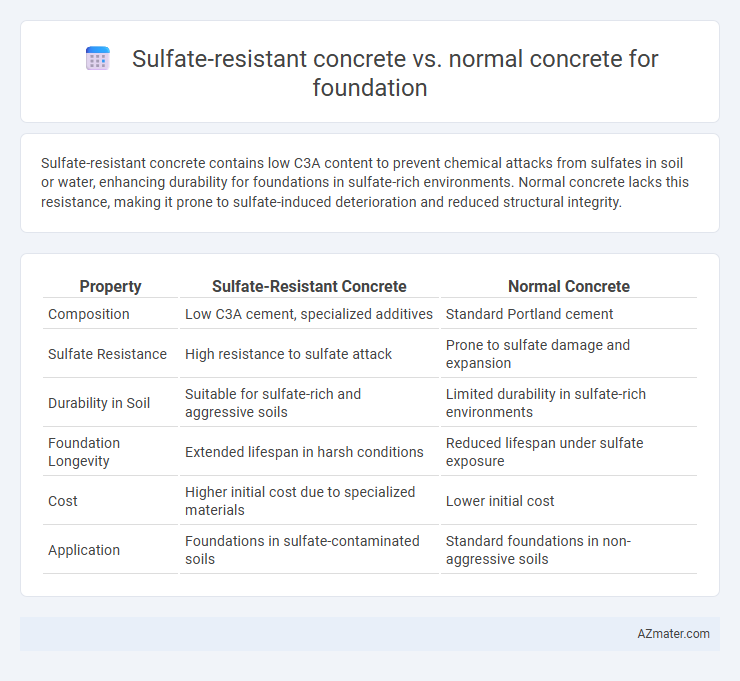Sulfate-resistant concrete contains low C3A content to prevent chemical attacks from sulfates in soil or water, enhancing durability for foundations in sulfate-rich environments. Normal concrete lacks this resistance, making it prone to sulfate-induced deterioration and reduced structural integrity.
Table of Comparison
| Property | Sulfate-Resistant Concrete | Normal Concrete |
|---|---|---|
| Composition | Low C3A cement, specialized additives | Standard Portland cement |
| Sulfate Resistance | High resistance to sulfate attack | Prone to sulfate damage and expansion |
| Durability in Soil | Suitable for sulfate-rich and aggressive soils | Limited durability in sulfate-rich environments |
| Foundation Longevity | Extended lifespan in harsh conditions | Reduced lifespan under sulfate exposure |
| Cost | Higher initial cost due to specialized materials | Lower initial cost |
| Application | Foundations in sulfate-contaminated soils | Standard foundations in non-aggressive soils |
Introduction to Concrete Types for Foundations
Sulfate-resistant concrete is specifically formulated to withstand sulfate attack in soils and groundwater, containing low-tricalcium aluminate cement to enhance durability in aggressive environments. Normal concrete, commonly used for foundations, lacks this resistance and may deteriorate when exposed to high sulfate concentrations, leading to structural damage over time. Choosing sulfate-resistant concrete is crucial for foundations in sulfate-rich areas to ensure long-term strength and stability.
Understanding Sulfate Attack in Concrete
Sulfate-resistant concrete is specifically designed to withstand sulfate attack, a chemical reaction between sulfate ions in soil or water and the hydrated cement paste in normal concrete that causes expansion, cracking, and deterioration. Normal concrete typically lacks the specialized cement composition, such as low C3A content, required to resist this aggressive sulfate environment, which compromises the structural integrity of foundations over time. Investing in sulfate-resistant concrete for foundations in sulfate-rich environments mitigates the risks of premature failure and costly repairs caused by sulfate-induced damage.
Composition Differences: Sulfate-Resistant vs. Normal Concrete
Sulfate-resistant concrete is specifically formulated with low tricalcium aluminate (C3A) content, typically below 5%, to minimize chemical reactions with sulfate ions, unlike normal concrete which contains higher C3A levels. It incorporates supplementary cementitious materials such as fly ash, slag, or silica fume to enhance durability and reduce permeability, preventing sulfate attack in foundations. Normal concrete primarily relies on ordinary Portland cement without these modifications, making it more susceptible to sulfate-induced expansion and deterioration in aggressive soil conditions.
Performance in Sulfate-Rich Environments
Sulfate-resistant concrete exhibits superior durability and reduced permeability in sulfate-rich environments compared to normal concrete, preventing aggressive sulfate ions from causing expansive reactions and structural damage. The use of low C3A cement or supplementary cementitious materials like fly ash enhances sulfate resistance by minimizing calcium aluminate phases susceptible to sulfate attack. This performance advantage significantly prolongs foundation lifespan and reduces maintenance costs in sulfate-contaminated soils or groundwater conditions.
Durability and Longevity Comparison
Sulfate-resistant concrete significantly outperforms normal concrete in durability and longevity, especially in environments with high sulfate exposure, such as soils or groundwater containing sulfate ions. The use of sulfate-resistant cement, often Type V, reduces chemical attacks that cause expansion, cracking, and deterioration, thereby extending the foundation's lifespan. Normal concrete tends to suffer from sulfate-induced damage leading to reduced structural integrity and more frequent maintenance in harsh environments.
Cost Implications of Sulfate-Resistant Concrete
Sulfate-resistant concrete typically incurs a higher initial cost than normal concrete due to the use of specialized cement, such as Type V Portland cement, and supplementary materials like fly ash or slag to enhance durability against sulfate attacks. This increased upfront investment can be offset by lower maintenance and repair expenses over the foundation's lifespan, especially in sulfate-rich soil or groundwater environments. Project budgets should consider long-term cost savings from reduced structural damage and extended service life when opting for sulfate-resistant concrete in foundation construction.
Environmental Considerations and Sustainability
Sulfate-resistant concrete significantly reduces environmental degradation by minimizing the leaching of harmful sulfates into surrounding soil and groundwater, unlike normal concrete which can deteriorate and release contaminants in sulfate-rich environments. Its enhanced durability extends the lifespan of foundations, lowering the frequency of repairs and reconstruction, thereby conserving natural resources and reducing carbon emissions associated with cement production. Opting for sulfate-resistant concrete improves sustainability in construction projects by promoting long-term structural integrity and minimizing ecological impacts.
Best Applications for Sulfate-Resistant Concrete
Sulfate-resistant concrete is ideal for foundations exposed to high sulfate concentrations in soil or groundwater, preventing chemical attacks that cause deterioration. It contains low C3A (tricalcium aluminate) content and uses supplementary cementitious materials like fly ash or slag to enhance sulfate resistance. This makes it best suited for sewage treatment plants, marine structures, and industrial foundations where sulfate-induced corrosion risks are significant.
Installation and Maintenance Requirements
Sulfate-resistant concrete requires precise mixing with low-permeability materials and sulfate-resisting cement to prevent chemical attacks during installation, while normal concrete uses standard Portland cement without specific additives. Maintenance of sulfate-resistant concrete involves regular inspections for sulfate ingress and ensuring proper drainage to minimize exposure, whereas normal concrete foundations typically need less frequent sulfate-focused upkeep but are more vulnerable to sulfate-induced deterioration over time. Proper installation techniques and tailored maintenance protocols for sulfate-resistant concrete significantly extend foundation durability in sulfate-rich environments compared to normal concrete.
Key Factors to Consider When Choosing Concrete for Foundations
Sulfate-resistant concrete is essential in foundations exposed to sulfate-rich soils, as it contains low C3A content to prevent chemical attacks that degrade normal concrete. The concrete's durability, permeability, and resistance to sulfate ions directly influence the foundation's longevity and structural integrity. When choosing concrete for foundations, key factors include sulfate concentration in soil or groundwater, environmental exposure conditions, and compliance with standards such as ASTM C150 and ACI 318.

Infographic: Sulfate-resistant concrete vs Normal concrete for Foundation
 azmater.com
azmater.com